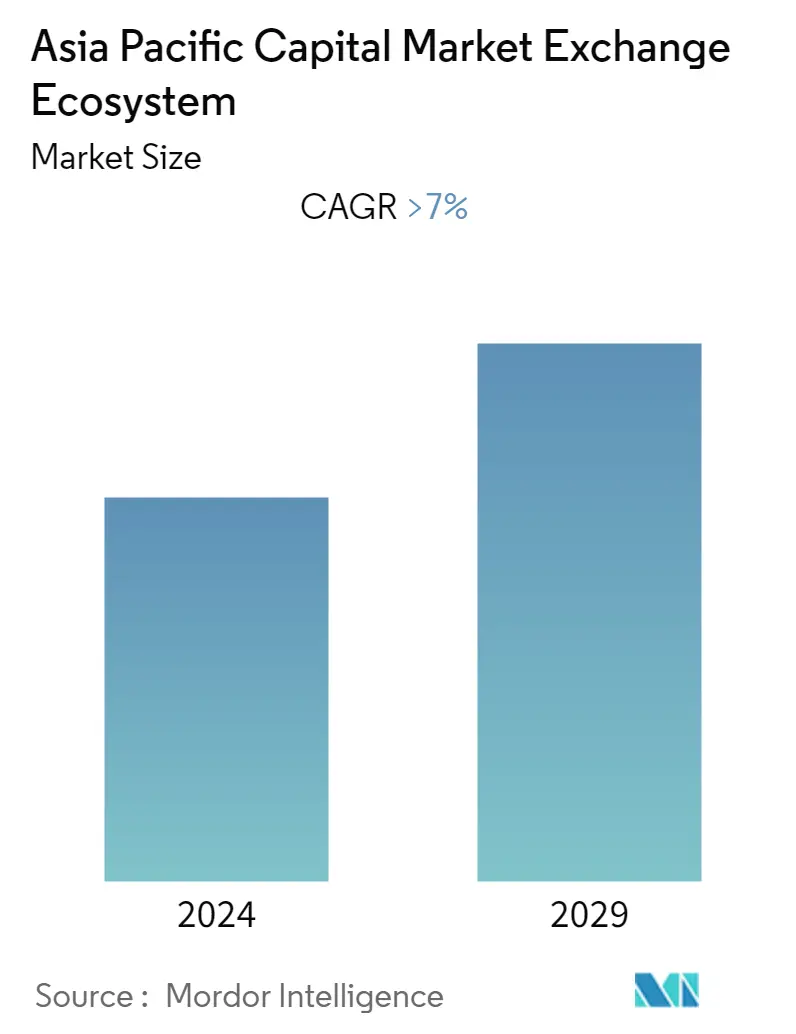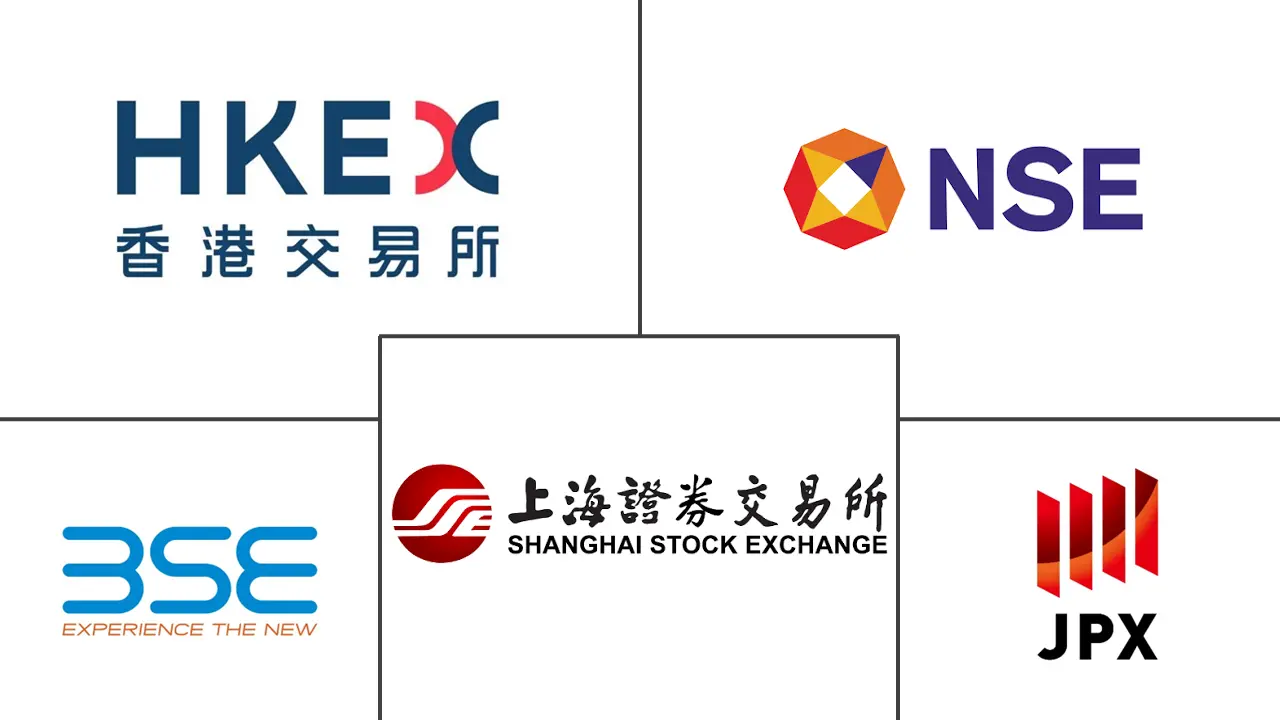Market Size of Asia Pacific Capital Industry Exchange Ecosystem

| Study Period | 2020 - 2029 |
| Base Year For Estimation | 2023 |
| Forecast Data Period | 2024 - 2029 |
| Historical Data Period | 2020 - 2022 |
| CAGR | > 7.00 % |
| Market Concentration | Medium |
Major Players
*Disclaimer: Major Players sorted in no particular order |
Asia Pacific Capital Market Analysis
The Asia-Pacific capital market exchange ecosystem is expected to register a rate of 4.5% per year over the next five years.
The US Capital Markets Exchange Ecosystem is expected to register a CAGR of more than 7% in the forecast period. The capital market plays a very crucial role in the growth and economic development of a country. It is an umbrella term used for trades done in person or on a virtual platform of various financial instruments. The exchange ecosystem refers to multiple systems and technologies used for trading in the capital market, as well as the workings of this system. In the capital market, entities such as businesses, governments, and individuals seek capital, and people or institutions are the investors. The capital market is composed of primary and secondary markets. The uncertainty from COVID-19 was expected to remain for the foreseeable future. The pandemic impacted the capital market, but the exchange ecosystem showed positive growth last year.
Players like the Shanghai Stock Exchange, the Tokyo Stock Exchange, the Hong Kong Stock Exchange, the Bombay Stock Exchange, the National Stock Exchange, and others are what drive Asia Pacific's capital market exchange ecosystem. When investing in developing and emerging markets in the region, it's important to think about how mature the market is. Countries such as Bangladesh, India, Indonesia, Malaysia, Pakistan, the Philippines, Sri Lanka, Thailand, and Vietnam are emerging markets. The capital markets' ecosystem is driven by things like new investments and changes in the economy.
Asia Pacific Capital Industry Segmentation
The capital market exchange ecosystem includes an ecosystem of markets in which debt- or equity-backed securities are bought and sold. These are carried out on various platforms known as stock exchanges. A complete analysis of the Asia-Pacific capital market exchange ecosystem, which includes an assessment of emerging trends, significant changes in market dynamics, and a market overview, is covered in the report. The Asia-Pacific capital market exchange ecosystem is segmented by type of market (primary market and secondary market), by financial instruments (debt and equity), by investors (retail investors and institutional investors), and by country (China, Japan, India, South Korea, Hong Kong, Singapore, and the rest of Asia-Pacific). The report offers market size and forecasts for the Asia-Pacific capital market exchange ecosystem in value (USD million) for all the above segments.
| By Type of Market | |
| Primary Market | |
| Secondary Market |
| By Financial Product | |
| Debt | |
| Equity |
| By Investors | |
| Retail Investors | |
| Institutional Investors |
| By Country | |
| China | |
| Japan | |
| India | |
| South Korea | |
| Hong Kong | |
| Singapore | |
| Rest of Asia-Pacific |
Asia Pacific Capital Market Exchange Ecosystem Size Summary
The Asia-Pacific capital market exchange ecosystem is poised for steady growth, driven by the activities of major exchanges such as the Shanghai Stock Exchange, Tokyo Stock Exchange, and Hong Kong Stock Exchange. This ecosystem encompasses a range of systems and technologies facilitating trades in various financial instruments, both in-person and virtually. The capital market serves as a crucial component of economic development, enabling businesses, governments, and individuals to seek and invest capital. Despite the challenges posed by the COVID-19 pandemic, the exchange ecosystem has demonstrated resilience and positive growth. Emerging markets in the region, including India, Indonesia, and Vietnam, are particularly significant, with factors like foreign direct investment and economic changes playing pivotal roles in shaping the market dynamics.
The growth of mid and small-sized businesses in the Asia-Pacific region further fuels the expansion of the capital market exchange ecosystem. These businesses often seek capital through avenues such as private equity and initial public offerings to support technological innovations and product expansions. The ecosystem is moderately fragmented, with a few key players dominating the landscape. Recent developments, such as the transfer system between the Beijing Stock Exchange and the Shanghai Stock Exchange, and the merger of the Shenzhen Stock Exchange's main board with the SME board, highlight ongoing efforts to optimize and integrate the region's capital markets. These strategic moves are expected to enhance the trading structure and foster deeper market connections, contributing to the overall growth of the Asia-Pacific capital market exchange ecosystem.
Asia Pacific Capital Market Exchange Ecosystem Market Size - Table of Contents
-
1. MARKET DYNAMICS
-
1.1 Market Overview
-
1.2 Market Drivers
-
1.3 Market Restraints
-
1.4 Porter's Five Forces Analysis
-
1.4.1 Bargaining Power of Buyers/Consumers
-
1.4.2 Bargaining Power of Suppliers
-
1.4.3 Threat of New Entrants
-
1.4.4 Threat of Substitute Products
-
1.4.5 Intensity of Competitive Rivalry
-
-
1.5 Impact of COVID-19 on the Market
-
-
2. MARKET SEGMENTATION
-
2.1 By Type of Market
-
2.1.1 Primary Market
-
2.1.2 Secondary Market
-
-
2.2 By Financial Product
-
2.2.1 Debt
-
2.2.2 Equity
-
-
2.3 By Investors
-
2.3.1 Retail Investors
-
2.3.2 Institutional Investors
-
-
2.4 By Country
-
2.4.1 China
-
2.4.2 Japan
-
2.4.3 India
-
2.4.4 South Korea
-
2.4.5 Hong Kong
-
2.4.6 Singapore
-
2.4.7 Rest of Asia-Pacific
-
-
Asia Pacific Capital Market Exchange Ecosystem Market Size FAQs
What is the current Asia Pacific Capital Market Exchange Ecosystem Industry size?
The Asia Pacific Capital Market Exchange Ecosystem Industry is projected to register a CAGR of greater than 7% during the forecast period (2024-2029)
Who are the key players in Asia Pacific Capital Market Exchange Ecosystem Industry?
Shanghai Stock Exchange, Tokyo Stock Exchange, Hong Kong Stock Exchange, Bombay Stock Exchange and National Stock Exchange are the major companies operating in the Asia Pacific Capital Market Exchange Ecosystem Industry.

